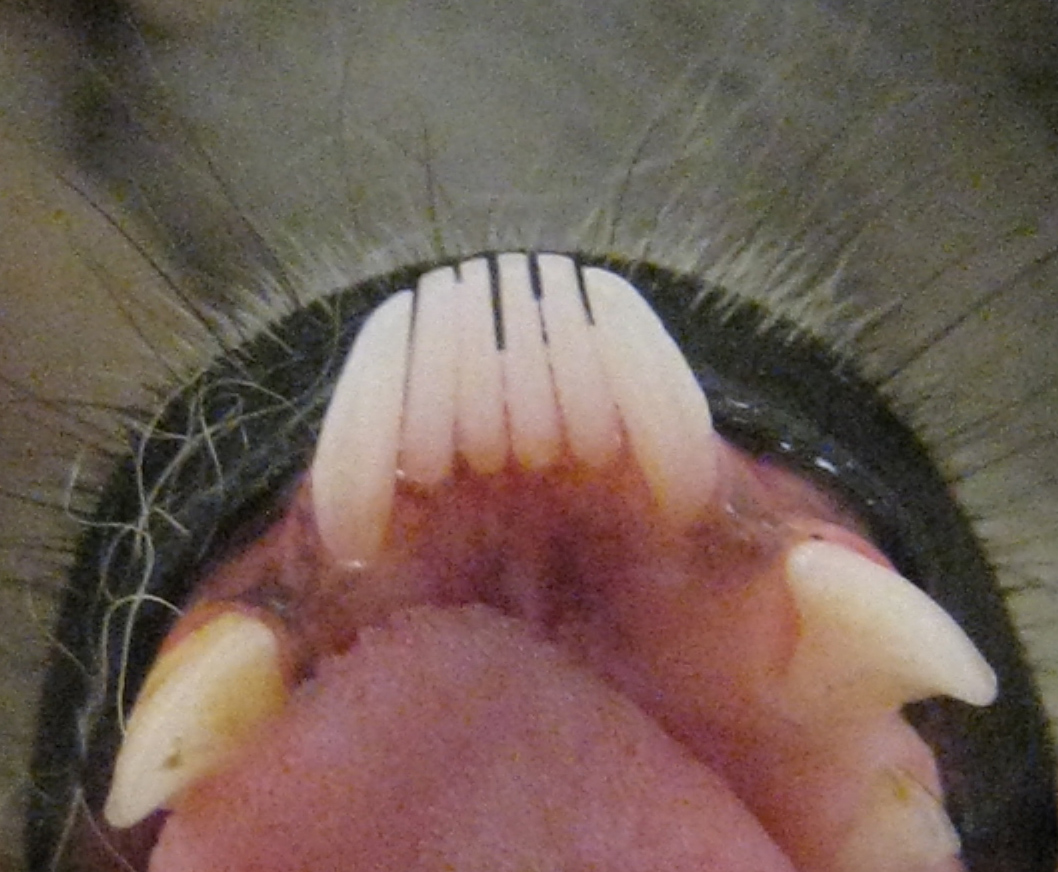
Lemurs are only found on the islands of Madagascar and Comoro. They live a very docile lifestyle with rarely any competition. Their agility allows for quick movement on the ground and in the trees, where they spend most of their time foraging for fruits and nuts to eat. Standard Lemur dentition consists of two incisors, one canine tooth, three premolars, and three molars. Lemurs use their teeth to groom other lemurs in the troop. The structure found in the lemurs mouth used for this purpose is called a toothcomb. Another use for the toothcomb is olfaction, or the sense of smell.
Spider Monkeys (New World Monkey/Playrrhini)

Spider Monkeys live in tropical climates like Central America. They travel in groups and forage for food in the trees. They have two incisors, one canine tooth, 3 premolars and three molars. Their teeth are heavily evolved for the environment that they live in. Because they live mostly in the trees, the spider monkeys teeth are evolved for feeding on food found mostly in the trees they inhabit. These foods include berries, nuts and eggs.
Baboon (Old World Monkey/Cercopithecidae)

Baboons live mainly in Africa in dry, hotter areas than the previous two. Like the spider monkey and lemur, baboons feed on berries and seeds when available, but due to the arid climate they live in, those are very scarce. Baboons live off of eating rodents and small animals wherever there is no edible vegetation. For this reason, baboons have very sharp canine teeth and broad molars so that they are able to kill and feed on the animals they catch. Their teeth have evolved for this purpose, making it easier for them to survive.
Gibbon (Lesser Ape/Hylobatidae)

Gibbons live in humid African climates near the southern half of the continent. They live in the tropical trees that are very fruitful. Because of this, the Gibbon's diet is made up of almost entirely fruit from the trees it inhabits. Gibbons also have very long, sharp canine teeth like the baboon, but they do not use theirs to hunt animals. For this reason, Gibbon's teeth are less evolved for killing, but instead more adapted for foraging.
Chimpanzee (Great Ape/Hominidae)

Chimpanzees can inhabit both the tropical trees and the dry, dusty climates of Africa. They mainly eat fruits, nuts, seeds and leaves from the trees they live in. They use their long canine teeth for foraging and their flat, broad molars to crush the fruits and nuts they find.
These primates are all relatively similar in their dentition, having canine teeth, incisors, premolars and molars. However, the environment they live in does have an effect on the adaptations of the teeth. As a result, not all of these primates teeth are the EXACT same. Some are specialized for foraging nuts and fruits in the trees while others are specialized for killing small rodents. Because of the tropical environments some of these primates live in, they are more adapted to feed off of plants, giving them a different set of teeth than the ones that live in dry climates.
I really liked your post. Good job comparing them and their dentition patterns. I liked finding out about their canine teeth, I really had no idea that they all had those. Your pictures really showed and compared the trait very well. The ones with the biggest teeth look to be the baboons and those are scary. I think maybe because they eat more meat than any of the other primates. Great Post!
ReplyDeleteYou do raise some unique dental traits, such as the dental comb and the larger canines of baboons, but otherwise, from reading your description, I'm left with the impression that there are very little differences between one primate to the next, other than the baboon, gibbon and chimpanzee having one less premolar than lemurs and spider monkeys.
ReplyDeleteDentition isn't just about tooth number. It is also about tooth morphology, or tooth shape, in particularly in the premolars and molars with their cusp shape. You can have shearing cusps for plant material, piercing cusps for insectivores and crushing/grinding cusps to generalized vegetarians. You discuss the differences in diet between all of these primates. It would have been interesting for you to identify how the teeth reflect these different diets as well for a complete comparative picture.
You do mention in your summary how dentition differs with diet, but you don't provide the information in the post to back this up.
I feel that you did a good job explaining and comparing traits across the primates. It is amazing how the dentition between primates have unique characteristics and functionality according to their diet and environment for protection. Nice pictures and nice post!
ReplyDeleteFirst of all, I really liked your pictures because it showed some differences in the primates. As a student who also looked at the dental structure, I realized that your post does not talk in detail about the differences of the primates. It would have been easier for you to analyze the relationship between the environment and the dental structure if you looked in to the differences the primates have. Otherwise, great summary, I enjoyed reading your post.
ReplyDelete